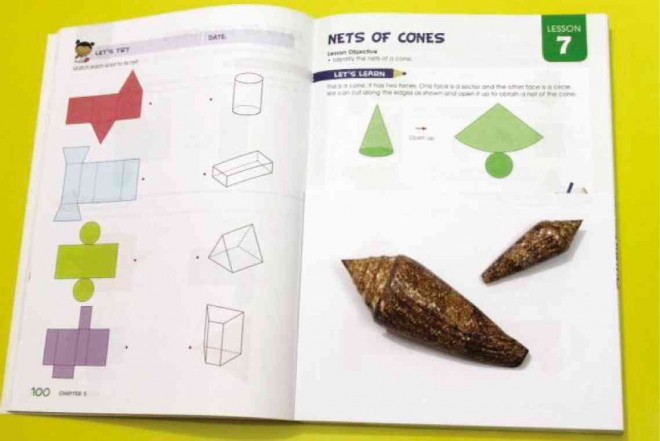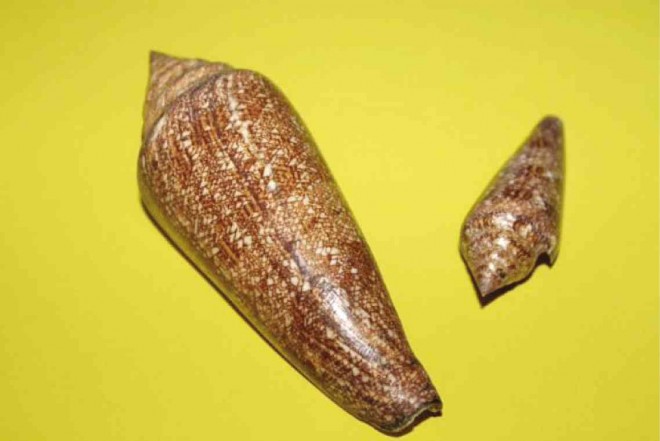Beautiful beasts

All have strong patterns and colors on the surface of their shells and are widely distributed throughout warm tropical waters.
They have venom, which they use to hunt other mollusks, marine worms and even fish. They inject the venom through a long specialized proboscis tipped with a poisonous tooth or harpoon, which is very thin and barbed at the end. The cone thrusts its proboscis forward and embeds the tooth in its prey, causing immediate paralysis.
The venom can also be deadly to humans as it may lead to respiratory paralysis. Living specimens should therefore be handled with extreme caution.
The cone shell I have chosen to represent this family of beautiful shells is the most famous of them all—the Conus gloriamaris, the “Glory of the Sea.”
Article continues after this advertisementFor a long time, only one specimen of this species was known to exist. As a result, it was the rarest, the most coveted and treasured species for more than two centuries.
Article continues after this advertisementBut the “Queen of Shells” gradually lost much of its former glory as more and more specimens were discovered over the years.
Pretty but deadly
The use of poison as a means of survival is employed by many animals living in the natural world.
Poison dart frogs of Central and South America secrete deadly poison from their skins. Their brilliant coloration warns predators to stay clear of the bitter and fatal meals. Bright, beautiful markings and colors also work to the advantage of other venomous animals such as cobras and mambas, salamanders, milkweed butterflies, bees, wasps, spiders and stingrays.
Plants use poison to protect and safeguard themselves from animals. The Amanita mushroom is beautiful but deadly and so are some common flowering plants like the oleander (adelfa), azalea, frangipani (kalachuchi), foxglove, daffodil and passion flower.
People also use poison to serve mean ends. The use of poison is in fact a tradition that is as old as humanity itself. Poison has been mankind’s deadly BFF ever since.
The first famous poisoning was that of the Greek philosopher Socrates in 399 BC. He was sentenced to death by a jury of 500 Athenian citizens and forced to drink a cup of poisonous hemlock, which killed him instantly.
Lucrezia Borgia (1480-1519) is known throughout history as the feminine paragon of moral decadence in Renaissance Italy because of her involvement and participation in the evil deeds of her father and her brother Cesare. She was the daughter of the Spanish cardinal Rodrigo Borgia who later became Pope Alexander VI in 1492.
Lucrezia’s family used her to advance their political ambitions and dynastic aspirations through a series of strategically arranged marriages. She was twice betrothed to Spanish noblemen and three times married to Italian princes for reasons of political expediency.
Rumors have persisted through the years about the real intention behind the holding of lavish parties by the Borgia family, alleging incest, poisoning and murder. Lucrezia was said to possess a hollow ring that she used to poison the drinks of her family’s rivals and enemies.
Potent poison
It may be said of cone shells, death cap mushrooms, poison dart frogs and Lucrezia Borgia that their beauty is the most potent of all their poisons.
The beautiful pattern and color of a cone shell, which you may find stranded in a tide pool after the tide has ebbed, will mesmerize you. But the shell’s beauty hides the fact that it harbors murder in its heart.
Exactly like the many animals that belong to the human race. There walk among us beautiful and handsome creatures, virtual Venuses and Apollos come down to earth from their pedestals up on Mount Olympus. Femmes fatales such as Lucrezia Borgia carry poison in their beautiful bodies. Like the Lorelei, they bewitch and seduce us with their beauty and their siren song, lure us and cause us to crash on the rocks and drown in the River of Fatal Attraction.
In the previous article that I wrote, I said that there was beauty in the beast. Inversely, there is also something beastly in the beautiful.
The bottom line is that appearances can be deceiving.
We should never judge a book by its cover. Open it and read its content to determine its character and integrity.
Very many of our textbooks contain very many errors, notwithstanding their beautiful and colorful covers. Defective textbooks contain venom and poison that are toxic to the mind, fatal to the heart. Like the cone shells, they may be beautiful, but they can also be deadly.
The author is the academic supervisor at Marian School of Quezon City and curator of the school’s Museum of Rocks and Shells. E-mail him at [email protected].
